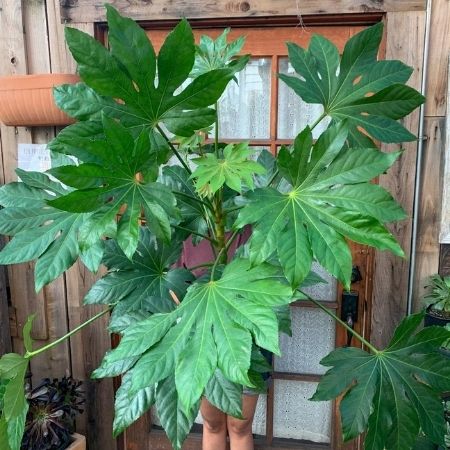
Even though the Fatsia japonica is hard to kill, it can sometimes be more complicated than we think. In this article, I will go over the 10 most common reasons why your Fatsia japonica is dying so you can make it healthy again.
The Fatsia japonica (also known as Japanese aralia) is an ornamental shrub with gorgeous, 30 inches long, palmate leaves, divide into 7 to 9 lobes. The robust evergreen, native to Japan, can grow up to 7 feet tall and 4 feet wide.
Despite its exotic appearance, Fatsia Japonica is a hardy and durable plant that is not prone to diseases as long as it grows in the optimal surrounding. However, if some conditions are not in line with its needs, the plant will show signs of weakening, discoloration, or wilting of the leaves.
Here is a list of the most common causes of these side effects.
Featured images by thesucculence.
Contents
10 Reasons why your Fatsia japonica is dying
1.Pests problem
Like all other houseplants, Fatsia japonica can be exposed to pests. It is often attacked by spider mites, especially if it grows in an area with dry air.
Spider mites are feed on plant sap, destroying the cell structure. You will detect their presence by the silver dots on the leaf and the delicate web on the leaf's back or between the stems.
If you do not stop them in time, the spots will gradually merge into larger wholes, causing discoloration, wilting, twisting, and leaf fall.
Therefore, immediately cut off all damaged leaves and destroy them. Treat the plant with a solution of neem oil which is a natural insecticide or insecticidal soap. You could coat or spray all parts of the plant, including the stems. Spider mites are very tiny, and sometimes you need to repeat the treatment until you are sure you manage to get rid of them.
2. Watering stress
Excessive or insufficient watering also causes disturbances in the plant's metabolism, which most often results in foliage yellowing.
Fatsia growing in a pot must have even and sufficient watering. It likes wet but not soggy soil. The watering frequency always depends on the size of the plant and the planter, soil composition, temperatures, and position.
Generally, you could water it two times a week or as soon as the surface of the substrate dries to a depth of 3 inches. The rule applies to the growing season from spring to autumn. In winter, reduce watering to once a week or once every ten days.
3. Light problems
Another reason why your Fatsia plant is dying could be because of lighting problems.
In its natural environment, Fatsia Japonica is a plant that grows in shady areas sheltered from direct sunlight by high vegetation. If it grows in a place where the blazing midday sun can reach it, the delicate thin leaves will quickly get sunburns. In addition, in such a place, the water will evaporate faster from the substrate, so the plant is constantly thirsty.
To avoid such problems, place your Fatsia in a shady position where it will receive filtered light. The ideal spots are next to the east or west window where the plant would get two or three hours of mild morning or afternoon sunlight.
Got your Click & Grow Smart Garden Today
Use code UNICAPLANTS10 for a 10% discount, click here.
4. Wrong kind of soil
Although not particularly picky about the soil composition, Fatsia Japonica can react with slow growth or smaller leaves if it grows in unsuitable soil.
When planting the plant, provide it with a quality humus-based substrate that retains some moisture but is never soaked. Avoid heavy, compacted clay or sandy and poor soils through which water drains too quickly.
You can also add a handful of compost to the substrate. It raises the nutritional value of the soil and slightly acidifies the substrate, which is in line with the needs of potted Fatsia Japonica.
5. Temperature stress
Sudden changes in temperature, cold airflow, or draft adversely affect Fatsia Japonica. These factors can impact the plant in such a way that it will die.
This problem is particularly pronounced in the winter months. Too much difference between day and night temperature does not leave the plant enough time to adapt, which usually causes leaf fall.
The temperature of the space in which it grows must be uniform. Therefore keep it in an evenly heated room. Fatsia Japonica generally does not like changes.
Although it benefits to spending the summer outside in a shaded part of the garden or balcony, a sudden change of environment usually has a counter-effect. Therefore, if your Fatsia Japonica is happy with its place, it is best not to move it!
6. Transplanting stress
Sometimes it happens that a newly transplanted Fatsia Japonica stagnates instead of growing faster, and some leaves even begin to wither.
Although in most cases the plant adapts to new circumstances, occasionally it could be a slow process in which the plant stagnates or gives few leaves. To avoid such phenomena, transplant the plant only when necessary - when part of the root begins to come out through the drainage holes.
If you have an adult, mature plant that grows in a large pot instead of transplanting it, you could replace the top substrate layer with fresh ones. It is most effective if you do it in the spring.
7. Disease
Fatsia Japonica loves moisture in the air and in the soil, which can lead to fungal diseases.
You will recognize them by dark, dotted clumps on the leaves or stems. It is more common in plants located in the shade or in those that live in a poorly ventilated room. If you notice dark spots on the leaves, cut off the infected leaves.
Treat the plant with some of the standard fungicides for houseplants. These products have a wide range of effects, so you don't have to know which fungus is the cause of the spotted leaves!
8. Too much fertilizer
As a fast-growing species, Fatsia Japonica consumes more nutrients from the soil than other plants, so it needs fertilization whether it grows in the garden or a pot.
Feed it twice a month with a mild, all-purpose fertilizer, following the instructions on the amount and concentration on the package. Excess nutrients, introduced into the soil the plant will not be able to use. The effect will not be faster or more vigorous growth than just the opposite: the lower leaves will begin to dry out and fall off, and the leaves defoliation will occur.
If you are unsure how much fertilizer to use, always start with lower doses or lower concentrations to see how the plant reacts. After all, it is always easier to increase the intake than to treat an overdosed plant.
9. Wrong pot size
Fatsia Japonica is a plant that grows fast (12 to 18 inches per season) and quickly overgrows the initial pot.
The root trapped in an inappropriate planter cannot function normally. It causes various disorders and reflects on the overall appearance and growth of the plant. On the other hand, if you plant your fatsia immediately in a large container, the plant will focus energy on the development of the roots instead of the development of the leaf mass, which results in a poorly branched and poorly leafy aboveground part of the plant.
To avoid the problems that an unsuitable container can cause, follow the simple rule that the diameter of the container should be one or two inches larger than the diameter of the roots.
Prune the plant to control its size and also shorten the root to one-third when transplanting. This way, even adult plants can thrive for years in a 27-inch-diameter pot.
10. Wrong kind of pot
The pot in which you will plant this beautiful and unusual plant must have drainage holes.
They prevent the accumulation of water around the root system. In containers without openings, water will collect and stay on the bottom. Over time, the constantly soaked substrate will cause root rot, and as a result, the stems and leaves will start to root too.
Like most shrubs, the root of this plant develops equally horizontally and vertically, in spindle-shaped form. Therefore, you could choose identically deep and wide pots instead of shallow and wide or narrow and deep ones.
In addition to providing enough space for root growth, planters that are equally deep and wide will ensure the plant's stability.

